Akshat Gupta
InterAct: Advancing Large-Scale Versatile 3D Human-Object Interaction Generation
Sep 11, 2025Abstract:While large-scale human motion capture datasets have advanced human motion generation, modeling and generating dynamic 3D human-object interactions (HOIs) remain challenging due to dataset limitations. Existing datasets often lack extensive, high-quality motion and annotation and exhibit artifacts such as contact penetration, floating, and incorrect hand motions. To address these issues, we introduce InterAct, a large-scale 3D HOI benchmark featuring dataset and methodological advancements. First, we consolidate and standardize 21.81 hours of HOI data from diverse sources, enriching it with detailed textual annotations. Second, we propose a unified optimization framework to enhance data quality by reducing artifacts and correcting hand motions. Leveraging the principle of contact invariance, we maintain human-object relationships while introducing motion variations, expanding the dataset to 30.70 hours. Third, we define six benchmarking tasks and develop a unified HOI generative modeling perspective, achieving state-of-the-art performance. Extensive experiments validate the utility of our dataset as a foundational resource for advancing 3D human-object interaction generation. To support continued research in this area, the dataset is publicly available at https://github.com/wzyabcas/InterAct, and will be actively maintained.
Efficient Knowledge Editing via Minimal Precomputation
Jun 04, 2025Abstract:Knowledge editing methods like MEMIT are able to make data and compute efficient updates of factual knowledge by using a single sentence to update facts and their consequences. However, what is often overlooked is a "precomputation step", which requires a one-time but significant computational cost. The authors of MEMIT originally precompute approximately 44 million hidden vectors per edited layer, which requires a forward pass over 44 million tokens. For GPT-J (6B), this precomputation step takes 36 hours on a single GPU, while it takes approximately 40 hours for Llama2-7B. Additionally, this precomputation time grows with model size. In this paper, we show that this excessive computational cost is unnecessary. Knowledge editing using MEMIT and related methods, such as ROME and EMMET, can be performed by pre-computing a very small portion of the 44 million hidden vectors. We first present the theoretical minimum number of hidden vector precomputation required for solutions of these editing methods to exist. We then empirically show that knowledge editing using these methods can be done by pre-computing significantly fewer hidden vectors. Specifically, we show that the precomputation step can be done with less than 0.3% of the originally stipulated number of hidden vectors. This saves a significant amount of precomputation time and allows users to begin editing new models within a few minutes.
Norm Growth and Stability Challenges in Localized Sequential Knowledge Editing
Feb 26, 2025Abstract:This study investigates the impact of localized updates to large language models (LLMs), specifically in the context of knowledge editing - a task aimed at incorporating or modifying specific facts without altering broader model capabilities. We first show that across different post-training interventions like continuous pre-training, full fine-tuning and LORA-based fine-tuning, the Frobenius norm of the updated matrices always increases. This increasing norm is especially detrimental for localized knowledge editing, where only a subset of matrices are updated in a model . We reveal a consistent phenomenon across various editing techniques, including fine-tuning, hypernetwork-based approaches, and locate-and-edit methods: the norm of the updated matrix invariably increases with successive updates. Such growth disrupts model balance, particularly when isolated matrices are updated while the rest of the model remains static, leading to potential instability and degradation of downstream performance. Upon deeper investigations of the intermediate activation vectors, we find that the norm of internal activations decreases and is accompanied by shifts in the subspaces occupied by these activations, which shows that these activation vectors now occupy completely different regions in the representation space compared to the unedited model. With our paper, we highlight the technical challenges with continuous and localized sequential knowledge editing and their implications for maintaining model stability and utility.
Lifelong Sequential Knowledge Editing without Model Degradation
Feb 03, 2025Abstract:Prior work in parameter-modifying knowledge editing has shown that large-scale sequential editing leads to significant model degradation. In this paper, we study the reasons behind this and scale sequential knowledge editing to 10,000 sequential edits, while maintaining the downstream performance of the original model. We first show that locate-then-edit knowledge editing methods lead to overfitting on the edited facts. We also show that continuous knowledge editing using these methods leads to disproportionate growth in the norm of the edited matrix. We then provide a crucial insight into the inner workings of locate-then-edit methods. We show that norm-growth is a hidden trick employed by these methods that gives larger importance to the output activations produced from the edited layers. With this "importance hacking", the edited layers provide a much larger contributions to the model's output. To mitigate these issues, we present ENCORE - Early stopping and Norm-Constrained Robust knowledge Editing. ENCORE controls for overfitting and the disproportionate norm-growth to enable long-term sequential editing, where we are able to perform up to 10,000 sequential edits without loss of downstream performance. ENCORE is also 61% faster than MEMIT and 64% faster than AlphaEdit on Llama3-8B.
PokerBench: Training Large Language Models to become Professional Poker Players
Jan 14, 2025Abstract:We introduce PokerBench - a benchmark for evaluating the poker-playing abilities of large language models (LLMs). As LLMs excel in traditional NLP tasks, their application to complex, strategic games like poker poses a new challenge. Poker, an incomplete information game, demands a multitude of skills such as mathematics, reasoning, planning, strategy, and a deep understanding of game theory and human psychology. This makes Poker the ideal next frontier for large language models. PokerBench consists of a comprehensive compilation of 11,000 most important scenarios, split between pre-flop and post-flop play, developed in collaboration with trained poker players. We evaluate prominent models including GPT-4, ChatGPT 3.5, and various Llama and Gemma series models, finding that all state-of-the-art LLMs underperform in playing optimal poker. However, after fine-tuning, these models show marked improvements. We validate PokerBench by having models with different scores compete with each other, demonstrating that higher scores on PokerBench lead to higher win rates in actual poker games. Through gameplay between our fine-tuned model and GPT-4, we also identify limitations of simple supervised fine-tuning for learning optimal playing strategy, suggesting the need for more advanced methodologies for effectively training language models to excel in games. PokerBench thus presents a unique benchmark for a quick and reliable evaluation of the poker-playing ability of LLMs as well as a comprehensive benchmark to study the progress of LLMs in complex game-playing scenarios. The dataset and code will be made available at: \url{https://github.com/pokerllm/pokerbench}.
Sylber: Syllabic Embedding Representation of Speech from Raw Audio
Oct 09, 2024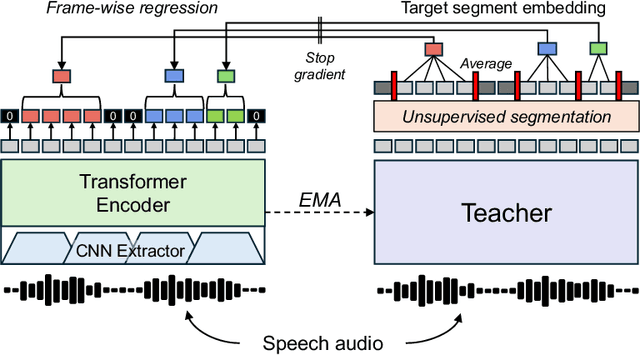

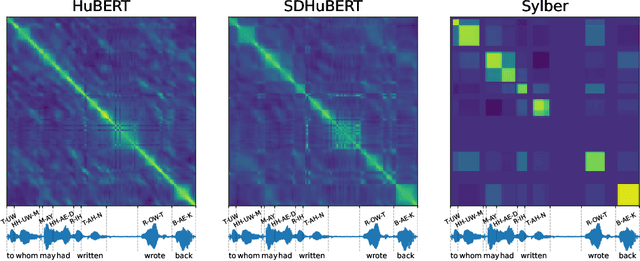
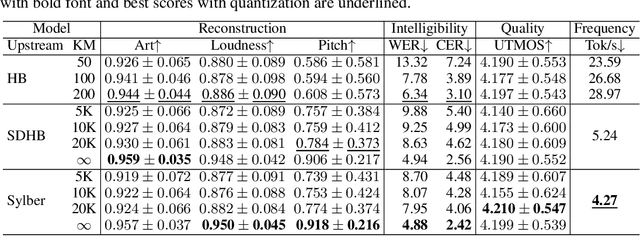
Abstract:Syllables are compositional units of spoken language that play a crucial role in human speech perception and production. However, current neural speech representations lack structure, resulting in dense token sequences that are costly to process. To bridge this gap, we propose a new model, Sylber, that produces speech representations with clean and robust syllabic structure. Specifically, we propose a self-supervised model that regresses features on syllabic segments distilled from a teacher model which is an exponential moving average of the model in training. This results in a highly structured representation of speech features, offering three key benefits: 1) a fast, linear-time syllable segmentation algorithm, 2) efficient syllabic tokenization with an average of 4.27 tokens per second, and 3) syllabic units better suited for lexical and syntactic understanding. We also train token-to-speech generative models with our syllabic units and show that fully intelligible speech can be reconstructed from these tokens. Lastly, we observe that categorical perception, a linguistic phenomenon of speech perception, emerges naturally in our model, making the embedding space more categorical and sparse than previous self-supervised learning approaches. Together, we present a novel self-supervised approach for representing speech as syllables, with significant potential for efficient speech tokenization and spoken language modeling.
FineZip : Pushing the Limits of Large Language Models for Practical Lossless Text Compression
Sep 25, 2024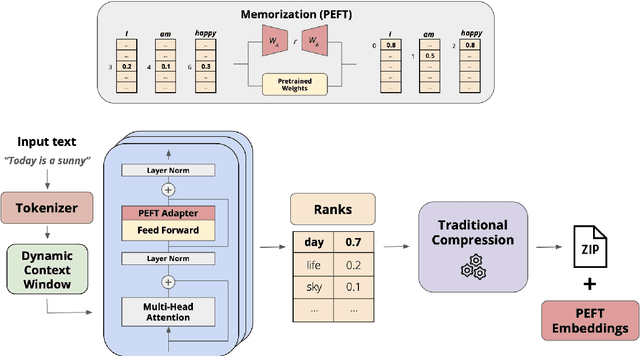
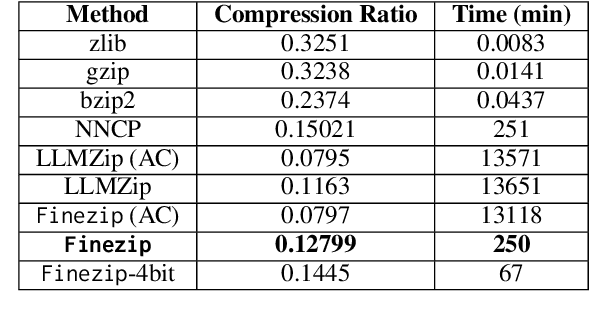
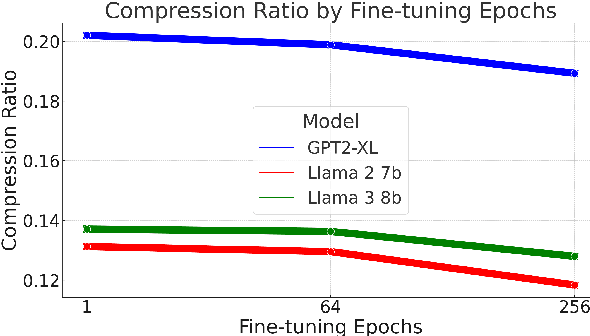
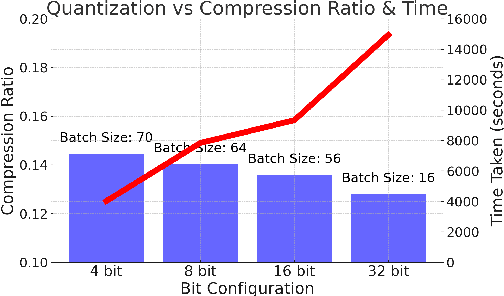
Abstract:While the language modeling objective has been shown to be deeply connected with compression, it is surprising that modern LLMs are not employed in practical text compression systems. In this paper, we provide an in-depth analysis of neural network and transformer-based compression techniques to answer this question. We compare traditional text compression systems with neural network and LLM-based text compression methods. Although LLM-based systems significantly outperform conventional compression methods, they are highly impractical. Specifically, LLMZip, a recent text compression system using Llama3-8B requires 9.5 days to compress just 10 MB of text, although with huge improvements in compression ratios. To overcome this, we present FineZip - a novel LLM-based text compression system that combines ideas of online memorization and dynamic context to reduce the compression time immensely. FineZip can compress the above corpus in approximately 4 hours compared to 9.5 days, a 54 times improvement over LLMZip and comparable performance. FineZip outperforms traditional algorithmic compression methods with a large margin, improving compression ratios by approximately 50\%. With this work, we take the first step towards making lossless text compression with LLMs a reality. While FineZip presents a significant step in that direction, LLMs are still not a viable solution for large-scale text compression. We hope our work paves the way for future research and innovation to solve this problem.
Is Bigger Edit Batch Size Always Better? -- An Empirical Study on Model Editing with Llama-3
May 01, 2024Abstract:This study presents a targeted model editing analysis focused on the latest large language model, Llama-3. We explore the efficacy of popular model editing techniques - ROME, MEMIT, and EMMET, which are designed for precise layer interventions. We identify the most effective layers for targeted edits through an evaluation that encompasses up to 4096 edits across three distinct strategies: sequential editing, batch editing, and a hybrid approach we call as sequential-batch editing. Our findings indicate that increasing edit batch-sizes may degrade model performance more significantly than using smaller edit batches sequentially for equal number of edits. With this, we argue that sequential model editing is an important component for scaling model editing methods and future research should focus on methods that combine both batched and sequential editing. This observation suggests a potential limitation in current model editing methods which push towards bigger edit batch sizes, and we hope it paves way for future investigations into optimizing batch sizes and model editing performance.
Uncertainty-aware Active Learning of NeRF-based Object Models for Robot Manipulators using Visual and Re-orientation Actions
Apr 02, 2024



Abstract:Manipulating unseen objects is challenging without a 3D representation, as objects generally have occluded surfaces. This requires physical interaction with objects to build their internal representations. This paper presents an approach that enables a robot to rapidly learn the complete 3D model of a given object for manipulation in unfamiliar orientations. We use an ensemble of partially constructed NeRF models to quantify model uncertainty to determine the next action (a visual or re-orientation action) by optimizing informativeness and feasibility. Further, our approach determines when and how to grasp and re-orient an object given its partial NeRF model and re-estimates the object pose to rectify misalignments introduced during the interaction. Experiments with a simulated Franka Emika Robot Manipulator operating in a tabletop environment with benchmark objects demonstrate an improvement of (i) 14% in visual reconstruction quality (PSNR), (ii) 20% in the geometric/depth reconstruction of the object surface (F-score) and (iii) 71% in the task success rate of manipulating objects a-priori unseen orientations/stable configurations in the scene; over current methods. The project page can be found here: https://actnerf.github.io.
A Unified Framework for Model Editing
Mar 21, 2024



Abstract:Model editing is a growing area focused on updating the knowledge embedded within models. Among the various methodologies, ROME and MEMIT stand out as leading "locate-and-edit" model editing techniques. While MEMIT enables batched editing of memories, ROME is limited to changing one fact at a time. This paper introduces a unifying framework that brings ROME and MEMIT under a single conceptual umbrella, optimizing for the same goal, which we call the "preservation-memorization" objective. This objective aims to preserve the representations of certain selected vectors while memorizing the representations of new factual information. Specifically, ROME optimizes this objective using an equality constraint, whereas MEMIT employs a more flexible least-square constraint. In addition to making batched edits, MEMIT also edits the model at multiple layers. We disentangle the distribution of edits to multiple layers from the optimization objective of MEMIT and show that these edit-distribution algorithms should be considered separate entities worthy of their own line of research. Finally, we present EMMET - an Equality-constrained Mass Model Editing algorithm for Transformers, a new batched memory-editing algorithm. With EMMET, we present a closed form solution for the equality-constrained version of the preservation-memorization objective. We show that EMMET is able to perform batched-edits on par with MEMIT up to a batch-size of 256 and discuss the challenges in stabilizing EMMET. By articulating the "locate-and-edit" model editing algorithms under a simple conceptual framework of "preservation-memorization", we aim to bridge the gap between intuition and mathematics and hope to simplify the journey for future researchers in model editing.
 Add to Chrome
Add to Chrome Add to Firefox
Add to Firefox Add to Edge
Add to Edge